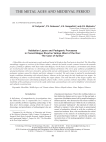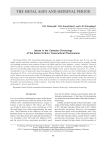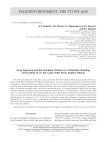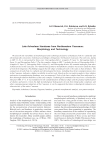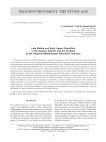Paleoenvironment, the stone age. Рубрика в журнале - Archaeology, Ethnology & Anthropology of Eurasia
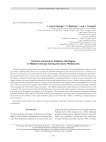
Hominin-Carnivoran adaptive strategies in Western Europe during the early Pleistocene
Статья
Бесплатно

Статья научная
This study focuses on the composition of the adhesives used to repair clay vessels, and on the technique of their preparation in the Late Neolithic and Chalcolithic (late 4th to early 3rd millennia BC) sites of Far Northeast Europe (the Republic of Komi and the Nenets Autonomous Okrug). Remains of adhesives were detected on 70 of 171 repaired pots. To date, five samples of ceramics from dwellings of the Chuzhyael culture have been analyzed. Gas chromatography-mass spectrometry revealed no markers of coniferous trees or bitumen; but did reveal markers of birch, suggesting that fractures and cracks on broken pots were plastered with birch tar. The composition of organic compounds in samples indicates the use of two vessels in the technological process: in one of them, birch bark was subjected to pyrolysis, while the other was a receptacle for tar. This comparatively complex technology reveals one more specialization in the domestic manufacture of the taiga hunter-gatherers, including the use of special furnaces. Analytic procedures employed by us open up new prospects for the study of the material culture of Far Northeast Europe, extend our knowledge of domestic manufacture, and offer new material for AMS dating.
Бесплатно

Insight into ceramic technologies at the Maikop site of Ust-Dzheguta, Karachay-Cherkessia
Статья обзорная
Бесплатно
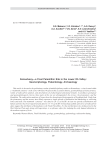
Komudvany—a Final Paleolithic Site in the Lower Ob Valley: Geomorphology, Paleontology, Archaeology
Статья научная
This article is devoted to the preliminary results of multidisciplinary studies at Komudvany—a site located within a “mammoth cemetery” in the Lower Ob basin. We present the excavation history, geomorphological characteristics, results of radiocarbon analysis, and descriptions of archaeological and faunal remains. According to geological and geomorphological criteria, three parts of the site are distinguished: the terrace, the promontory, and the fl oodplain. The radiocarbon analyses of bones show the chronological heterogeneity of fl oodplain fi nds. Finds from the promontory and the terrace most likely represent a single episode of habitation and butchering or collecting bones and tusks. The mammoth “cemetery” was dated to 20–12 cal ka BP. At least one episode of habitation and human activities has been registered and dated to 15–14 cal ka BP. Archaeological fi nds and series of radiocarbon dates suggest the attribution of Komudvany to the Final Paleolithic. It is the northernmost site of that period in the West Siberian Plain and, along with Lugovskoye, is a reference object for studying the early human habitation in the northern regions of Asia.
Бесплатно
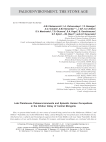
Статья научная
Here, we present initial results of a new course of research being carried out at the Moiltyn-am, Orkhon-1, and Orkhon-7 Paleolithic sites in the Orkhon River Valley, central Mongolia. Our research focuses on the Moiltyn-am site, which preserves a cultural and chronological sequence from the Final Middle to the Late Upper Paleolithic. Results from analyses of rare earth elements, Strontium (Sr) isotopes, and faunal assemblages are correlated with data on paleoenvironmental conditions in the region during MIS-3 and MIS-2. Our conclusions are based in part upon post- depositional changes detectable in archaeological material from cultural layers at the Moiltyn-am site revealed through convergent analyses of stratigraphy, sedimentology, planigraphy, and the comparison of Sr isotopes in sediments and osteological remains. XRF-derived geochemical data from the Moiltyn-am sedimentary sequence yields evidence of past climatic conditions. We correlated these data with human occupational episodes in the Orkhon Valley during the Middle and Upper Paleolithic, and the results are analyzed in the context of extant paleoenvironmental information from northern Mongolia. Our results indicate a relatively humid climate prevailed during MIS-3, followed by a period of aridification, and the redeposition of sediments at Moiltyn-am. Faunal analysis reveals that Bos sp. and equids were the principal prey species for humans in the Final Middle to Initial Upper Paleolithic, supplemented by members of the Caprinae during the Early Upper Paleolithic. A complex mammoth fauna inhabited forest-steppe and steppe landscapes in the Khangai Mountains during MIS-3 and MIS-2.
Бесплатно
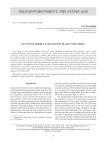
Levantine Middle Pleistocene blade industries
Статья научная
The origin of Near Eastern Middle Pleistocene blade industries is discussed with reference to the Levallois reduction-technique. Special attention is paid to the Gesher Benot Ya'akov site, in Israel, where the Levallois technology is the earliest in the region (ca 800 ka BP). Whereas later Acheulean industries show no continuity with the Levallois tradition, the alternation of predominant Middle Pleistocene technologies indicates changing adaptation strategies caused by ecological conditions. Accordingly, the early appearance of the laminar technology in the Near East evidences local evolution rather than immigration. The major factors underlying this innovation were adaptation and the intrin sic development of the Levallois system. Laminar technologies, which are fi rst evidenced by certain Levantine sites even earlier than Gesher Benot Ya'akov, became widely distributed at the Acheulo-Yabrudian stage of the late Acheulean. A well-developed blade technology is demonstrated by the Amudian industry of Qesem, Israel, dating to 400–200 ka BP.
Бесплатно

Materials from dwelling 2 on Suchu island, the Lower Amur (1977 season, excavation III)
Статья
This article presents the fi nal results of excavations at one of the largest Neolithic sites in northeastern Asia— a settlement on Suchu Island on the Amur. Most of the rich collection (3967 spec.), owned by IAET SB RAS (stone tools, ceramics, ornaments, and artistic and ritual artifacts), has not been described before. This publication focuses on the analysis of artifacts from dwelling 2 (excavation III, 1977). We describe the construction of this semi-underground dwelling, circular in plan view. The typological analysis of the lithics indicates a complex economy. Many of them (arrowheads, projectile points, inserts, knives, plummets) relate to hunting and fi shing, and to processing carcasses (end-scrapers, scrapers, burins, combination tools), others are chopping tools. The distinctive feature of the lithics is that some are bifacial. The analysis of the ceramics suggests that they belong to the Late Neolithic Voznesenovskoye culture. The use of binocular microscopy allowed us to assess the technological and constructive properties of the ceramics, as well as their morphological, decorative, and functional features. Non-ut ilitarian artifacts shed light on the worldview of the Suchu people. The collection dates to the mid-second millennium BC.
Бесплатно
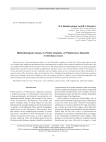
Methodological issues in pollen analysis of Pleistocene deposits in Denisova Cave
Статья научная
Denisova Cave, in the northwestern Altai, is a key Paleolithic complex in North Asia. Pleistocene deposits in the cave contain lithic industries and human fossils documenting the evolution of the cultural traditions of Denisovans in the second half of the Middle and in the Upper Pleistocene. This study addresses methodological issues in paleogeographic interpretation of pollen records relating to Quaternary deposits of cave sites. We present the results of the analysis of recent and subrecent spectra of cave sediments and soil samples taken at sites of characteristic plant communities in natural zones of the Anui River valley near Denisova Cave. Findin gs from taphonomic study of pollen microremains from loose sediments in the East Chamber of the cave make it possible to obtain a correct climato-stratigraphic and climato-phytocenotic interpretation of pollen spectra from Pleistocene deposits in Denisova Cave.
Бесплатно
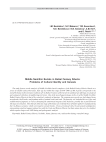
Middle Neolithic burials in Baikal-Yenisey Siberia: problems of cultural identity and genesis
Статья научная
The study focuses on the analysis of Middle Neolithic burial complexes of the Baikal-Yenisey Siberia. Based on a series of reliable radiocarbon dates, their age lies within the range of 6190–5900 cal BP. It partly corresponds to the end of the hiatus in the mortuary traditions of Cis-Baikal. Features of the burial rite and funerary offerings are analyzed and compared with those of neighboring territories. One of the most frequent images in the art of the Middle Neolithic Baikal-Yenisey Siberia is that of the waterfowl, rendered as fi gurines. The common grave goods are leaf-shaped stone arrowheads, shell beads, and pendants made of animal bones and teeth. The funerary rite included the use of fi re and reddish mineral pigment, as well as disrupting the anatomical integrity of the skeletons, possibly due to partial burial (the data are tentative). Most burials of the late stage of the hiatus are evidently those of hunter-gatherers manufacturing the Ust-Belaya ceramics, which were found in certain burials. A bone arrowhead with a biconical point and fi gurines representing waterfowl suggest cultural ties with the Urals and Western Siberia; but their nature has yet to be clarifi ed, which requires large-scale AMS-dating and paleogenetic analysis.
Бесплатно

Middle paleolithic bone retouchers: size or proportions
Статья
Bone retouchers are the most common tools for processing lithic raw material in the Middle Paleolithic of Eurasia. Typically, they are perceived by Paleolithic researchers as informal, unmodifi ed tools made from bone blanks accidentally obtained during the extraction of marrow. In this article, we introduce new data on a large collection of bone retouchers from Chagyrskaya Cave (in the Altai Mountains). Their dimensions demonstrate a high standardization of blanks, indicating the intentional selectivity of Neanderthals. Selection also concerned animal species and the anatomical positions of bones. We found that morphological characteristics such as the number of active areas and the degree of their modifi cation did not affect the size of the retouchers and attest only to the reorientation of tools during lithic processing. In the course of retouching, cross-sections of diagnostic traces in the active areas underwent signifi cant changes: whereas at the early stages they reveal “furrows” with V-shaped cross-sections, multiple blows against the processed lithic resulted in the deformation of the original form, which eventually resembled an upturned trapeze. The comparison of bone retouchers from several multicultural Middle Paleolithic complexes in Eurasia (Chagyrskaya and Denisova caves in the Altai, Kabazi V site in the Crimea, and Barakayevskaya Cave in the Caucasus) evidences similar proportions but considerable variation in size. Proportions, then, are an inherent functional characteristic of bone retouchers, which does not depend on either the cultural context or the raw material base.
Бесплатно
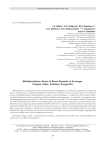
Multidisciplinary study of burnt deposits at Surungur, Fergana valley, Southern Kyrgyzstan
Статья
Бесплатно

Статья научная
We describe new findings relating to Neolithic burials at two cemeteries in the Northern Angara area, excavated in 2012 by the Boguchany archaeological expedition. The sites are located at the outlet of the Zelinda—the right tributary of the Angara. Two burials were revealed at Ust-Zelinda-1, and five at Ust-Zelinda-2. We describe preserved remains and the funerary rite, and analyze radiocarbon dates generated from the human bones. On the basis of archaeological parallels, we attribute certain burials to the Isakovo culture. Burial practices include the use of “ocher” and the supine position of the buried along the Angara, heads to the south, upstream of the site. Calibrated radiocarbon dates, details of the funerary rite, grave goods and their typological characteristics, as well as the placement of graves within the cemeteries, suggest that three chronological groups existed within the 7499–5583 cal BP (5550–3634 cal BC) interval. The 14C date of the third group (5718–5583 cal BP, or 3769–3634 cal BC), details of the funerary rite, and grave goods are indicative of the Late Neolithic (Isakovo culture of the Southern Angara). Burials of the second group, which is the best represented (7157–6555 cal BP, or 5208–4606 cal BC), resemble those of the classic Isakovo tradition. The burial (without grave goods) attributed to the fi rst chronological group dates to 7499–7317 cal BP, or 5550– 5368 cal BC. It is hypothesized that “proto-Isakovo” traditions originated on the Northern Angara, having later spread to the Southern Angara.
Бесплатно

